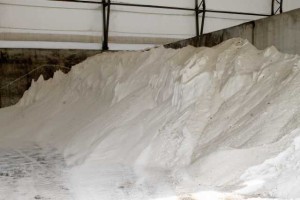The Phosphate And Potash Outlook For 2014
After declining steadily during the last two years, phosphate prices are staging a powerful and earlier-than-expected rally while potash prices appear to have found a bottom and are beginning to turn up in some regions.
In the case of phosphate, the price run-up during what typically is a seasonally slow period has surprised most market observers. The spot price of DAP loaded on a barge at New Orleans (NOLA) had spiked to about $425 per ton in mid-January, a 33% or $105 increase since the end of November. NOLA SWAP contracts for February, March and April were bid at $435 to $445 per ton in mid-January, indicating that prices likely would trade at these higher levels into the spring application season.
Several factors typically combine to move markets by this much in such a short time. In this case, the combination of continued positive demand prospects, a lean distribution pipeline and several small planned and unplanned production outages has tightened the market and changed sentiment overnight.
Some Positive Signs
Despite somewhat less robust drivers, demand prospects continue to look positive. Global shipments of the leading phosphate products are forecast to climb to a record 64-66 million tons in 2014, up from our estimate of slightly more than 63 million in 2013.
The demand outlook in the Americas remains outstanding. In Brazil, shipments continue to set new records. We estimate that total plant nutrient shipments increased to 30.9 million tons last year, up 5% from 2012. Shipments are projected to increase to around 32 million tons in 2014. Imports of the leading phosphate products including MicroEssentials jumped to nearly 5.1 million tons in 2013, an increase of 36% or 1.4 million from 2012 and more than double the volume of just five years ago. Imports are projected to stay at or near this lofty level in 2014.
In North America, shipments of the leading phosphate products climbed to a modern era record of 10.1 million tons in 2012-13. We estimate that shipments will remain at elevated levels of 9.8 million tons in 2013-14 and 9.9 million in 2014-15. Shipments during the 2013 fall application season were off about 9% from the 2012 record due to the later harvest, but movement exceeded the seven-year Olympic average by 10%. We project that shipments this spring will rank as the second highest in the modern era and exceed the seven-year Olympic average by 7%.
Channel inventories in many countries were pulled down to relatively low levels during the slow price burn of the last two years. India provides the best example. Our Delhi team estimates that destocking of wholesale and retail inventories likely will total about 2.3 million tons for the fertilizer year that ends March 31, 2014. As a result, we project that Indian DAP imports will rebound from an estimated 3.6 million tons this year to 5 to 6 million tons in 2014-15. This raises the likelihood that recent price increases will hold into the second half of 2014 because Indian buyers are not expected in the market until the second quarter.
On the supply side of the ledger, the cumulative impact of several small planned and unplanned outages has reduced nearby availability. For example, we took down the large No. 5 DAP granulation plant at our Riverview, FL, complex for an extended turnaround at the end of November (or during what we expected to be a seasonally slow period). Modifications will enable this unit to produce DAP, MAP or MicroEssentials once it is back online in March. The Ma’aden facility in Saudi Arabia also continues to ramp up at a slower-than-expected pace. And planned or unplanned outages in Australia, Mexico and Tunisia have reduced supplies.
Looking At Potash
In the case of potash, prices appear to have found a bottom and are beginning to turn up in some regions. Now the question is will potash prices follow the same dynamic as nitrogen and phosphate?

Potash prices appear to have found a bottom and are beginning to turn up in some regions.
The price of blend grade MOP at a Midwest warehouse has dropped to the current spring fill price of $350 per ton, a decline of more than 40% or $240 from a peak of around $590 during the last half of 2011. The price of blend grade MOP delivered to a Brazilian port declined to a low of about $310 per tonne in December — a drop of 45% or $250 from the peak in March 2012. Brazilian spot prices had turned up to about $320 per tonne in mid-January with offers for February loads indicated in the $350 per tonne range.
We continue to forecast that demand will increase significantly this year in response to lower prices as well as a need to restock thin distribution pipelines in some countries. In particular, we project that global MOP shipments will jump to a record 57 to 59 million tons in 2014, up from about 54 million in 2013.
The “Big Six” are expected to lead the rebound this year. North America, Brazil, China, India, Indonesia and Malaysia combined account for roughly two-thirds of world MOP shipments. Each region is expected to register a gain this year. India is noteworthy with MOP imports projected to increase from about 3.2 million tons in 2013-14 to 4 to 4.5 million tons in 2014-15. Brazil is expected to extend its streak of record imports again this year with MOP imports of roughly 8 million tons, up from 7.7 million in 2013.
In North America, we project that MOP shipments will total more than 9.92 million tons in 2013-14 and then inch up to 9.97 million in 2014-15. Shipments last fall were off about 5% from the modern era record set a year earlier, but movement was up 4% from the seven-year Olympic average. We project that shipments during the upcoming spring application season will roughly equal movement a year ago and the seven-year Olympic average.
Distributors are expected to remain reluctant and take priced positions until a trigger event convinces them that not only the bottom is in but there is significant upside risk. Several potential developments could trigger a change in sentiment including the settlement of first-half China contracts, realization of higher prices in Brazil, an uptick in agricultural commodity prices and the creation of a new export organization by Russian and Belarussian producers.
North American producers continue to carry high inventories. MOP stocks at on- and off-site warehouses totaled 2.99 million tons on December 31, down about 5% from a year earlier but 25% greater than the seven-year Olympic average for this date. If our global demand forecasts are on target, North American producer inventories are projected to drop later in 2014.
Several uncertainties still overhang both markets. The most important, in my view, is the direction of agricultural commodity prices this year. The January 10 USDA reports surprised markets. The bump in corn prices in response to smaller-than-expected estimates of the U.S. crop and carry-out stocks was good news for crop input industries. However, the world produced a blockbuster crop in 2013-14 and global grain and oilseed inventories will increase significantly this year. Markets will closely watch the development of the Southern Hemisphere crop, the USDA’s March 31 Prospective Plantings report, China’s corn import appetite, biofuels policies, the Northern Hemisphere growing season and instincts of the large herd of speculative traders for future direction.






